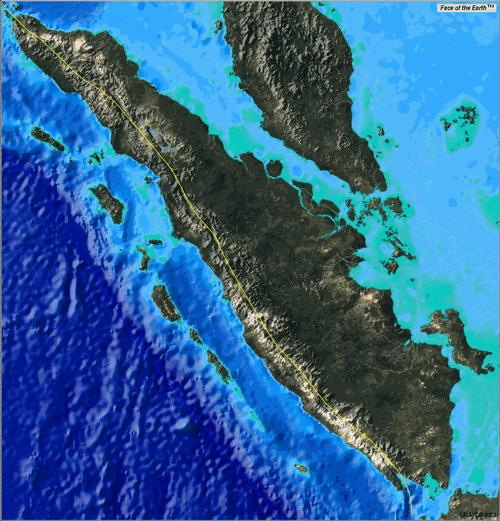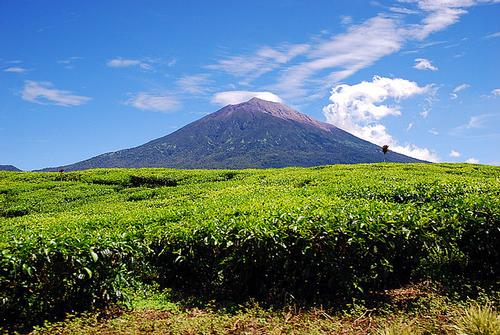SUMATRA
Geography and Landscape

Geography and Landscape
| Basic information | |
| Official language | Malay |
| Capital | Medan (grootste stad) |
| Area | 473.481 km² |
| Population | 58,557,211 (2020) |
| Currency | Indonesian rupee (IDR) |
| Web | .id |
| Code. | IDN |
| Tel. | +62 |
Popular destinations INDONESIA
| Bali | Java | Sumatra |
Geography and Landscape
Geography
Sumatra (or Sumatera) is the sixth largest island in the world (with an area of about 470,000 km²) and belongs to Indonesia.
The provinces of Sumatra (and some small islands) are:
Aceh - capital: Banda Aceh
Bangka-Belitung - Capital: Pangkal Pinang
Bengkulu - Capital: Bengkulu
Jambi - Capital: Jambi
Lampung - capital city: Bandar Lampung
Riau - Capital: Pekanbaru
Riau Archipelago (Kepulauan Riau) - Capital: Tanjung Pinang
West Sumatra (Sumatra Barat) - capital: Padang
South Sumatra (Sumatra Selatan) - capital: Palembang
North Sumatra (Sumatra Utara) - capital: Medan

Landscape
The longest axis of the island runs roughly from the northwest to the southeast and crosses the equator roughly in the middle. The interior of the island is dominated by two geographical regions: the Barisan Mountains in the west and swamp plains in the east.
To the southeast of Sumatra, separated by the Soenda Strait, lies the island of Java. To the north lies the Malay Peninsula, separated from Sumatra by the Strait of Malacca. To the east lies Kalimantan (the Indonesian part of Borneo), across the Karimata Strait.
To the west is the Indian Ocean. The Barisan mountain range forms the backbone of the island. This region owes its fertile soil and beautiful nature to volcanic activity, for example around Lake Toba. Gold and coal can also be found here.
To the east, large rivers carry deposits from the mountains, forming the marshlands in the lowlands.
The Kerinci is the highest volcano in Indonesia and the highest peak in Sumatra.
 Kerinci, highest mountain in SumatraPhoto: WahyuS CC 2.0 Generic no changes made
Kerinci, highest mountain in SumatraPhoto: WahyuS CC 2.0 Generic no changes made
Climate and Weather
Sumatra lies on the equator, so the climate is very warm. In general, the temperature is between 26 and 28 degrees Celsius. Sumatra has a tropical rainforest climate, especially in the months of April, May and June it is also very warm along the coast. The average rainfall is high, from 2.43 metres in the east to 3.12 metres in the west, especially in the highlands of Minangkabau.
Plants and Animals
Plants
Sumatra used to be largely tropical rainforest, with some unique plant species such as rafflesia. Rafflesia arnoldii is the largest flower in the world. The plant itself consists of thin threads that are attached to a special type of vine. It uses these threads to extract its food from the vine. The flower has a diameter of almost one metre.
It was found in 1818 during a research trip in the interior of Sumatra by the Englishman Stamford Raffles and his companions. As his companion Arnold was the first to see the flower, the flower was given the appropriate name "Rafflesia arnoldii" by Robert Brown who first described the flower in 1821.
Animals
Orang utans, tapirs and Sumatran tigers, among others, lived on Sumatra. The Orang Utan is the best known animal of Sumatra. Orang-utans (Pongo) are a genus of great apes with long arms and reddish, sometimes brown, hair that live in Borneo and Sumatra. On Sumatra lives the Sumatran orang-utan (Pongo abelii). The name Orang-utan comes from the Malay Orang Hutan which means forest man. Of all the great apes, orang-utans climb the trees the most. They are very intelligent. The habitat of the orang-utans has been reduced considerably in recent years by logging, mining and forest fires. Babies are also illegally caught to be sold as pets. The hunters usually shoot the mother in order to catch the young. Because of this, the Sumatran orang-utan is threatened with extinction.
Sources
theworldofinfo.com/indonesia
Wikipedia
CIA - World Factbook
BBC - Country Profiles
Copyright: Team The World of Info